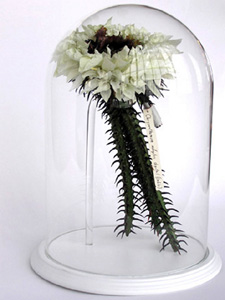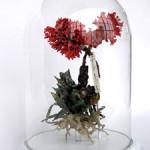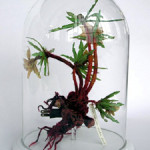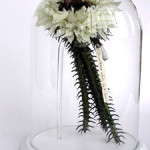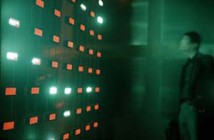Wake up, Boston. Shed the winter lethargy, stretch your limbs, send a few leaves in the direction of the sun and go see “Office Plants.”
Bearing titles such as Canna adaptus electric (120V) and presented as specimens, these plants have apparently evolved connections to the electronic world. Canna adaptus plugs in to a typical wall socket, Hyacinthus adaptus connects to an iPod, and Protea adaptusextends a CAT-V network cable. Meanwhile, none of them are actually connected – their apparent potential for connection, in conjunction with Burkhardt’s implied narrative of collection and preservation, asks questions rather than answering them.
The taxonomic classification and the bell jars containing the plants reference 19th century natural history museum presentation, and by extension, the corresponding social Darwinist metanarrative of progress via conflict that became influential among Western elites during the Victorian era. Today, while social Darwinist thinking is no longer academically respectable, its legacy runs deep within our culture in our acceptance of conflict – and its uncomfortable companion, the disposition of victims and survivors – as possessing some claim to being “natural” and therefore inevitable. By adopting the visual language of the natural history museum but assigning his plants some characteristics that we would consider “unnatural” to plants, Burkhardt blurs the line between natural and synthetic, questioning our concept of the natural and destabilizing categories and hierarchies that depend on this definition. This mode of presentation also calls attention to the prominent role of cultural institutions such as museums in supporting – or questioning – such metanarratives.
The plants themselves are deliciously, idiosyncratically believable; they have to be seen to appreciate the richness of detail and play of contrasting sheens and textures, fragile petals against sturdy stems, soft fuzz that invites and thorns that repel. These sensual qualities propel my imagination into high gear, seducing me through the looking glass to indulge in a personal fantasy of their former lives…
…Shivering beside a chilly 50th floor expanse of plate glass, wishing someone would think to water the plants, Protea adaptus telecommunicata slumps in its pot, petals drooping with sadness – neglected, isolated and generally depressed. Originally purchased during a short-lived spasm of office beautification, Protea’s existence is now all but forgotten. Meanwhile, the fluorescent-lit center of the office hums with electronic activity and life. Gigabytes zip from one computer to the next, and then halfway around the world, courtesy of a sprawling rootsystem of servers, hubs, routers and miles of tangled cable. Sounds of rapid typing, one-sided phone conversations, printers spitting out pages, and headphone hum fill the air.
Feeling increasingly trapped, the plants in Protea’s window discuss their desperate situation:
Protea archaicus apocalyptica: “If we are to survive as a species, we must return to our roots, to the time-honored, traditional ways of harmony with the earth. Our unnatural life in this window is doomed!”
Protea nihilus postmoderna: “Return to nature is impossible because we are mediated by centuries of selective hothouse breeding, and who can prove that there is any such thing as nature anyway?”
Protea bizarrus fundamentala: “Silence, ye sinners and haters of America! Repent, for the rapture cometh, when all liberal, muslim and gay plants shall be charred to a crisp, and dominion on earth shall be restored to the faithful among plants, who alone among all living things are made in the image of God.”
Protea meditatus newagea: “Breathe, my fellow plants. Drink in the universal energy, allowing it to drench your roots and fill your leaves. All that you need lies within.”
Protea egotistus capitalista: “I’m thirsty. I wanna be on the executive floor, where you get your own extra large window, imported Italian designer pot, personalized natural-spectrum lighting from The Sharper Image and bottled water on demand.”
Protea adaptus elects to reach out, to attempt connection and communication. Maybe this adaptive survival strategy works, maybe it doesn’t. In his statement, Burkhardt notes “the long history of conflicting feelings we as humans have about our environment. We want to both preserve nature and control it and everything we do has an effect on everything around us.”
In final analysis, “Office Plants” successfully invites narrative speculation, setting the stage and introducing a fascinating cast of characters while leaving plot and outcome to our imagination. Strong, individual artistic vision and flawless technical execution merge with love of detail and a splash of humor to create a substantial yet delightful artistic cocktail.
- Brian Burkhardt, Hyacinthus adaptus audio (ipod)
- Brian Burkhardt, Canna adaptus digital (cable), mixed media, 2004
- Brian Burkhardt, Chrysanthemum adaptus digital (cable), mixed media, 2004
Links:
Miller Block Gallery
"Brian Burkhardt: Office Plants" is on view until March 15 at Miller Block Gallery located at 14 Newbury St., Boston.
All images are courtesy of the artist and Miller Block Gallery

